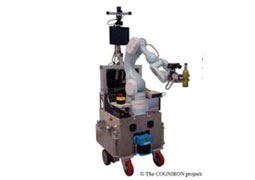Can't make your kids tidy up their room? Try a robot and boost you parental ego.
 Can robots learn lessons from humans and adapt their behaviour accordingly? This is what the scientists working for the COGNIRON (Cognitive Robot Companion) project wanted to achieve with their studies on the perceptual, reasoning and learning capabilities of robots. But how did they do this?
Can robots learn lessons from humans and adapt their behaviour accordingly? This is what the scientists working for the COGNIRON (Cognitive Robot Companion) project wanted to achieve with their studies on the perceptual, reasoning and learning capabilities of robots. But how did they do this?
One of the major technical challenges was to provide a reference "Cognitive Architecture" for autonomous robots that interact with humans and provide services to them. To address this problem, the researchers defined a large number of competences that such robots might need, and then combined collections of these functions in a set of "three key experiments".
As a result, the Robot Home Tour experiment demonstrated practical abilities for guided learning of 'human home environment' models. This model integrates information about the topological structure, appearance, functional structure and semantic labels of the environment. The Curious Robot experiment demonstrated cooperative task achievement, particularly for "fetch and carry" tasks. Eventually, the Learning Skills and Tasks experiment focussed on arranging and interacting with objects. An impressive and entertaining result is the Chief Cook Robot which is able to repeat the cooking tasks he is taught.
COGNIRON started as a European Commission pathfinder research initiative in the area of service robotics with the aim of 'developing robots that interact with humans and are able to perceive, decide, communicate and learn in an open-ended way'. The project opened the way to a field that has since become a mature research area in the Framework Programmes for research at the European Commission since 2002. Among application possibilities of such technology, we may imagine robots adapted to small SME's production needs, or tools to help handicapped people in their daily life and on a longer term, smart robots for everyone's use.



 Media Centre
Media Centre 





